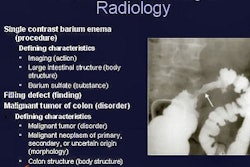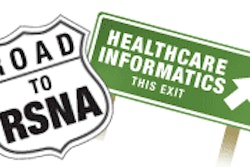The implementation of electronic health record (EHR) systems holds the promise of great benefits for U.S. healthcare. Computer-based systems in medicine, such as PACS and RIS in radiology, have a demonstrated track record of cost and quality improvement both for the practice and its patients. In addition, almost all medical groups are utilizing some form of electronic application-based billing and patient scheduling system.
Although there is widespread support for the adoption of EHRs, a recent survey reports that only a limited number of U.S. medical group practices utilize the technology.
The Medical Group Management Association (MGMA) Center for Research in Englewood, CO, and the University of Minnesota School of Public Health in Minneapolis recently surveyed more than 3,300 U.S. medical group practices to assess their use of information technology. The project, Assessing Adoption of Health Information Technology, was funded by the U.S. government's Agency for Healthcare Research and Quality (AHRQ).
The survey, conducted in January and February this year, measured the current rates of EHR adoption, which EHR features are more frequently used, barriers to adopting an EHR system, and how EHR users rated the benefits of the technology.
Adoption
The report found that just 14.1% of all medical group practices use an EHR system, and just 11.5% indicated that an EHR system was fully implemented for all physicians and at all practice locations.
According to the data, the EHR adoption rate increased with practice size. Groups with five or fewer full-time equivalent (FTE) physicians reported a 12.5% adoption rate; those with six to 10 FTE physicians showed a 15.2 % adoption rate; groups with 11-20 FTE physicians reported an 18.9% adoption rate; and groups of 20 or more FTE physicians had a 19.5% adoption rate. However, the report stated that a substantial number of practices indicate that they are planning to adopt EHRs in the future.
"If these plans were to be fully carried out, about 60% of practices would have adopted EHR technologies two years from now, and 80% among the largest practices (21 or more physicians)," the authors wrote (Health Affairs, September/October, Vol. 24:3, pp. 1323-1333).
Benefits
Practices that have implemented EHRs gave uniformly high marks to the technology, which enables improved access to medical record information and improved workflow from integrating the systems into a practice. Other EHR benefits cited by respondents included improved patient communications, improved accuracy for coding evaluation and management procedures, and improved drug-refill capabilities. Charge capture, clinical decision-making, and claims submission improvements were also touted by EHR adopters.
An improvement to some or all of these practice elements would appear to be a worthwhile goal of any medical group; however, the survey data showed a different result.
"A separate analysis showed that practices that have not implemented EHRs and have no plans to do so in the next two years rate each of the (expected) benefits lower than practices that have implemented, are implementing, or plan to implement EHRs," the researchers stated.
The report found that EHR systems are not uniform in functionality and that not every medical group fully uses the capabilities of its EHR system. Some applications were more prevalent than others. More than 97% of the respondents with an EHR reported that their system had functions for patient medications, prescriptions, patient demographic, and visit/encounter notes. However, less than 65% reported the EHR provided drug formulary information or clinical guidelines and protocols. Also of note, only 83.1% of respondents said their EHR was integrated with their practice billing system.
Barriers
Not surprisingly, given the volatile nature of procedure reimbursement and malpractice premiums, group practices cited a "lack of capital resources to invest in EHR" as the top barrier to adoption.
The researchers noted that an important barrier to adoption is that practices are not convinced EHRs will improve their performance. The research indicates that the average purchase and implementation cost of an EHR system was approximately $33,000 per FTE physician. Maintenance costs were an additional $1,500 per physician per month. Smaller practices had a slightly higher cost per physician for technology adoption.
"Added to the monthly maintenance cost, the initial cost, even if amortized over five years at 8% interest, would translate into about a 10% reduction in take-home pay each year for most primary care practices," the authors wrote.
A concern about a loss of productivity during the transition to the EHR system was also cited by many respondents as a barrier to adoption.
"Preliminary analysis of our interviews suggests that a substantial fraction of practices also experience a reduction in practice productivity during implementation of 10%-15% for at least several months," the authors noted.
In addition to the double-digit productivity drop experienced by practices integrating EHRs, the study found that the average cost for an EHR implementation were significantly greater than vendor estimates.
"We also found that for most practices, actual costs of implementation were higher than they had expected, with cost overruns averaging about 25% over the vendors' estimates," the authors reported.
The survey respondents and study authors observed that there is a dearth of information on EHR system selection and integration. They noted that the development of standardized questions to ask EHR vendors; model requests for proposal for HER systems and EHR contracts; information on integration capabilities of EHR products with various practice management systems; educational programs on how to select and implement an EHR system; and certification for EHR vendors would be welcomed by the physician community.
"An early finding from our interviews is that the transition from computer-based administrative information systems to fully implemented EHRs is a major undertaking that creates dislocation among the clinical staff and is more complicated, more difficult, and more expensive than we or most practices expected," the authors wrote. "The majority of practices are finding the transition difficult even if the physicians and nurses are fully supportive."
By Jonathan S. Batchelor
AuntMinnie.com contributing writer
October 28, 2005
Related Reading
Small practices may benefit financially from electronic health records, September 15, 2005
Medical Records Institute offers IT IQ test, July 29, 2005
HIMSS lends support to EHR effort, April, 26, 2005
SNOMED CT: Electronic health records enhance radiology patient safety, April 13, 2005
Brailer outlines national health IT goals, challenges at HIMSS, February 18, 2005
Copyright © 2005 AuntMinnie.com



















